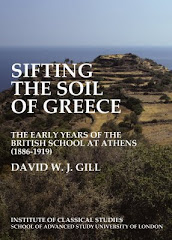The main research topics for students were on
pottery and
sculpture. However several worked on coins. Among the Cambridge students, Francis Brayne-Baker of Christ’s College studied coins from Asia Minor. Sidney W. Grose also of Christ’s College worked on the McClean coins in the Fitzwilliam Museum and subsequently became honorary keeper there. Alan Wace of Pembroke College published a coin hoard of Hellenistic coins found at
Sparta.
Among the Oxford students, Joseph G. Milne of Corpus Christi College excavated in Egypt (publishing coins from the Faiyum), and subsequently became deputy keeper of coins in the
Ashmolean Museum (1931-51). John W. Crowfoot of Brasenose College worked on the iconography of Thracian coins, linking them to specific inscriptions from Athens. E.S.G. Robinson of Christ Church worked on numismatics in the collections at Athens, and collected coins on his journey through Lycia and Pamphylia. He subsequently became assistant keeper, and then keeper, in the department of Coins and Medals at the
British Museum.
Select BibliographyBaker, F. B. 1892. "Coin-types of Asia Minor."
Numismatic Chronicle 12: 89-97.
—. 1893. "Some rare or unpublished Greek coins."
Numismatic Chronicle 13: 21-35.
Crowfoot, J. W. 1897. "A Thracian Portrait."
Journal of Hellenic Studies 17: 321-26.
Grenfell, B. P., A. S. Hunt, D. G. Hogarth, and J. G. Milne. 1900.
Fayum towns and their papyri. Egypt Exploration Fund. Graeco-Roman branch. Memoirs, vol. 3. London: Egypt Exploration Fund.
Grose, S. W. 1915. "Croton."
Numismatic Chronicle 15: 179-91.
—. 1916a. "A dekadrachm by Kimon and a note on Greek coin dies."
Numismatic Chronicle 16: 113-32.
—. 1916b. "Some rare coins of Magna Graecia."
Numismatic Chronicle 16: 201-45.
—. 1917. "Primitiae Heracliensis."
Numismatic Chronicle 17: 169-89.
—. 1920. "The Balliol College collection."
Numismatic Chronicle 20, 4th ser.: 117.
—. 1923.
Catalogue of the McClean collection of Greek coins [in the] Fitzwilliam Museum, Cambridge. Cambridge: Cambridge University Press.
Milne, J. G. 1905a. "A hoard of coins from Egypt of the fourth century B.C."
Revue archéologique 5: 257-61.
—. 1905b. "Roman coin-moulds from Egypt."
Numismatic Chronicle: 342.
—. 1908a. "The copper coinage of the Ptolemies."
Annals of Archaeology and Anthropology 1: 30-40.
—. 1908b. "The leaden token coinage of Egypt under the Romans."
Numismatic Chronicle: 287.
—. 1911a. "The Dadia hoard of the coins of Knidos."
Numismatic Chronicle: 197.
—. 1911b. "Hoard of silver coins of Knidos."
Numismatic Chronicle: 197.
—. 1912. "Two hoards of coins of Cos."
Numismatic Chronicle: 14.
—. 1913. "Coutermarked coins of Asia Minor."
Numismatic Chronicle: 389-98.
—. 1914. "A hoard of coins of Temnos."
Numismatic Chronicle: 260.
—. 1916. "A hoard of bronze coins of Smyrna."
Numismatic Chronicle: 246.
—. 1917. "The Alexandrian coinage of the early years of Hadrian."
Numismatic Chronicle 17: 31.
—. 1917. "Some Alexandrian coins."
Journal of Egyptian Archaeology 4: 177-86.
—. 1920. "Two Roman hoards of coins from Egypt."
Journal of Roman Studies 10: 169-84.
—. 1922. "The coins from Oxyrhynchus."
Journal of Egyptian Archaeology 8: 158-63.
—. 1929. "Ptolemaic coinage in Egypt."
Journal of Egyptian Archaeology 15: 150-53.
—. 1931. "Woodeaton coins."
Journal of Roman Studies 21: 101-09.
—. 1933. "The Beni Hasan coin-hoard."
Journal of Egyptian Archaeology 19: 119-21.
—. 1935. "Report on coins found at Tebtunis in 1900."
Journal of Egyptian Archaeology 21: 210-16.
—. 1936. "Pliny on the First Coinages at Rome."
Classical Review 50: 215-17.
—. 1938. "Roman literary evidence on the coinage."
Journal of Roman Studies 28: 70-74.
—. 1940. "The "Philippus" coin at Rome."
Journal of Roman Studies 30: 11-15.
—. 1943. "Pictorial coin-types at the Roman mint of Alexandria."
Journal of Egyptian Archaeology 29: 63-66.
—. 1945. "Alexandrian coins acquired by the Ashmolean Museum, Oxford."
Journal of Egyptian Archaeology 31: 85-91.
—. 1946. "The problem of the early Roman coinage."
Journal of Roman Studies 36: 91-100.
—. 1950. "Pictorial coin-types at the Roman mint of Alexandria: a supplement."
Journal of Egyptian Archaeology 36: 83-85.
—. 1951. "Pictorial coin-types at the Roman mint of Alexandria: a second supplement."
Journal of Egyptian Archaeology 37: 100-02.
Robinson, E. S. G. 1914. "Coins from Lycia and Pamphylia."
Journal of Hellenic Studies 34: 36-46.
—. 1946. "Rhegion, Zankle-Messana and the Samians."
Journal of Hellenic Studies 66: 13-20.
—. 1951. "The coins from the Ephesian Artemision reconsidered."
Journal of Hellenic Studies 71: 156-67.
Wace, A. J. B. 1907/08. "Laconia I. Excavations at Sparta, 1908. § 8. A hoard of Hellenistic coins."
Annual of the British School at Athens 14: 149-58.



